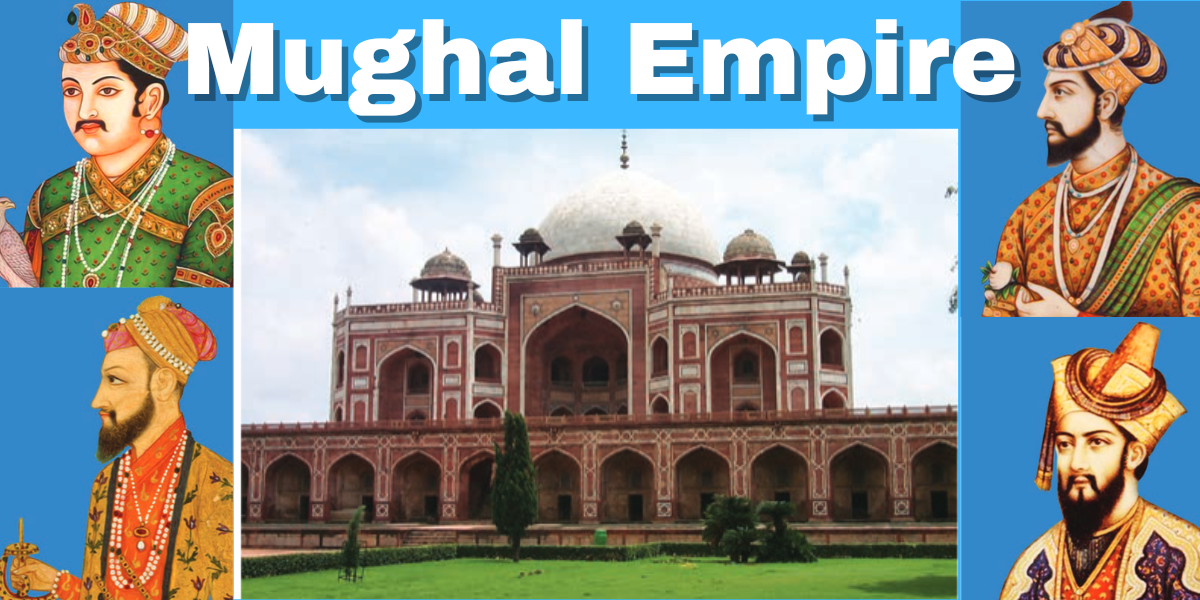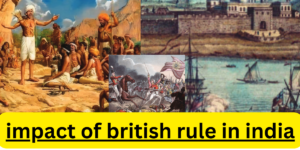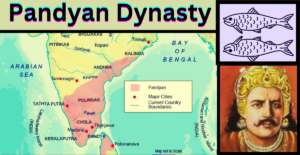Mughal Empire
Mughal Empire (1526–1857)
Mughal Empire,The word Mughal comes from the Persian or Arabic word Mughal. It means Mongol i.e. Mongol.The Mughal Empire was established in 1526 by defeating the last Sultanate of Delhi named Ibrahim Lodi.The significance of the Mughal territory has signified the development of pan India’s cultural development also.The decisive battle fought between Babur and the Rajput army of Sanga resulted in the consolidated Empire building of the Mughal on the northern side of India.
Mughal Empire flag:
Principal Imperial Standard – Alam: The primary imperial standard of the Mughals was known as the Alam. It featured a predominant moss green color.
Design: The design of the Alam included a depiction of a lion and sun (Shir-u-khurshid ) facing the hoist of the flag.
Symbolism: The lion and sun motif on the flag held symbolic significance, representing strength and power. The use of these symbols reflected the imperial grandeur of the Mughal Empire.
Mughal Empire Rulers:
| Ruler | Reign (CE) |
| Babur | 1526-1530 |
| Humayun | 1530-1540, 1555-1556 |
| Akbar | 1556-1605 |
| Jahangir | 1605-1627 |
| Shah Jahan | 1628-1658 |
| Aurangzeb | 1658-1707 |
| Bahadur Shah I | 1707-1712 |
| Jahandar Shah | 1712-1713 |
| Farrukhsiyar | 1713-1719 |
| Muhammad Shah | 1719-1748 |
| Ahmad Shah Bahadur | 1748-1754 |
| Alamgir II | 1754-1759 |
| Shah Alam II | 1759-1806 |
| Akbar II | 1806-1837 |
| Bahadur Shah Zafar | 1837-1857 |
Babur (1526-1530):
The Mughal Empire was founded by Babur, the Central Asian ruler. His real name was Zahiruddin Mohammad.Babur was born in Pargana in the Ustakistan region.Babur’s father, Umar Shaikh Mirza, was a minor ruler of Parganas.Babur was of Genghis Khan (Mongol) descent on his mother‘s side and Timur (Turkey) on his paternal
- Babur had power struggles with many kingdoms.
- Uzbeks – Turks
- Sabawil-Shia-Iran
- Ottoman-Turkic Sunni sect
There was a power struggle between the two kingdoms to become a great ruler like Timu.Babur wanted to conquer Samarkand but did not succeed.Later, he lost his kingdom, Parganavi.He tried hard to save the kingdom, but could not.In 1519, he began his march towards Afghanistan.He conquered Ghazni, Kabul and Lahore.Later, Daulat Khan Lodi and Rana Sanga invited Babur. They called for an invasion of India and the conquest of Ibrahim Lodi.Babur then marched towards India along the Silk Road.Daulat Khan Lodi resisted while entering India via Lahore in 1525. So there was a war between Daulat Khan and Babur.Babur defeated Daulat Khan in this battle.
Battle of Panipat 21 April 1526:
The Afghan Lodi dynasty ruled the Delhi Sultanate from 1451, and Ibrahim Lodi had been king since 1517. Babur, a descendant of Timur and Genghis Khan, ruled Ferghana (Uzbekistan) and conquered Kabul in 1504.Invited by Daulat Khan, the governor of Punjab, Babur tried to challenge Ibrahim Lodi’ s rule after suffering a setback in capturing Samarkand.In 1524, Babur reached Lahore but was repulsed by Lodi’s forces.
Despite failed attempts with the support of the rebels, Babur prepared better in 1526 and efficiently organized his small army.Babur surprised the army dependent on Lodi’s cavalry by introducing gunpowder rifles and field artillery.Babur’s strategic acumen played an important role, including the Tulkuma (military wing) and the Araba (cannon firing carriages).Lodi’s 50,000-strong army was defeated by just 12,000 troops.The death of Ibrahim Lodi put an end to the Lodi dynasty and the Delhi.This war paved the way for Mughal rule in India and established Babur’s dynasty.
Battle of Canwa ( 1527 CE):Mughal Empire
The Battle of Khanwa was fought on 16 March 1527 between Babur and Rana Sanga, the Rajput ruler of Mewar.Rana Sanga aimed to overthrow Babur, whom he saw as a foreigner ruling in India, and tried to expand the Rajput territories by capturing Delhi and Agra.The Afghan chiefs supported Rana Sanga because of Babur’s unfulfilled promises.Aware of Rana Sanga’s advance towards Agra, Babur took a defensive position at Khanwa in present-day Rajasthan.Babur’s victory is attributed to his “superior communism” and his use of modern techniques, including cannons and musk.The treachery of the Hindu chief Silhadi, who joined Babur’s army with 6,000 men, played an important role in the defeat of Rana Sanga.
Battle of Chanderi (1528):
The Battle of Khanwa was followed by the Battle of Chanderi, and Babur learned of Rana Sanga’s preparations for renewed confrontation.Babur aimed to isolate Rana Sanga by defeating one of his important allies, Medini Rai, the ruler of Malwa.On 20 January 1528, Babur offered Shamshabad to Medini Rao as a peace token in exchange for Chanderi, but the offer was rejected.Babur’s army captured the outer fort of Chanderi at night.It was followed by the capture of the Upper Fort the next morning.Medini Roy, having no hope of victory, arranged a jauhar where the women and children in the fort self-immolated themselves.A small group of soldiers committed collective suicide at Medini Rao’s house. However, Babur did not appreciate this sacrifice in his autobiography.
Battle of Ghaghra (1529 CE):
After conquering the Rajputs, Mughal emperor Babur moved eastwards and defeated the Afghans at the Battle of Ghagra in 1529.This conquest extended Babur’s control over northern India, including parts of Punjab, Agra, Awadh, Gwalior, Bihar and parts of Rajasthan.Babur established Delhi as the capital of the Mughal Empire.However, Babur did not live long to enjoy the fruits of his conquests. B died in 1530, four years after the battle of.Apart from being the founder of the Mughal Empire, Babur was also a talented poet and writer. His biography, Baburnama (in Persian) and Tusk-i-Baburi (in Turkish), provide insights into his life and period.He developed various gardens, the most famous being the Rambagh Garden in.
Humayun (1530-1540) (1555-1556) :
- Humayun, who ruled from 1530 to 1540, succeeded his father Babur at the age of 23.It faced many challenges such as financial instability, hostility to Afghanistan and the tradition of power-sharing among the brothers.
- They fought provincial rulers like Bahadur Shah and Sher Khan who posed threats to Mughal rule.He signed an agreement with Shere Khan, giving him control of the eastern territory in exchange for loyalty. But he lost Gujarat and Malwa to Bahadur Shah.Sher Khan, later Sher Shah, defeated Humayun at the Battle of Chausa in 1539.Humayun was exiled for 15.
- Humayun wandered in Sind. Hamida married Banu Begum, and had a son, Akbar, in 1542.He took refuge in the court of the Iranian king and recaptured Qandhar and Kabul in . After the fall of the Sur Empire in 1555, he regained the Mughal throne with the help of the loyal officer Bairam Khan.
- fell and died in the fort of Delhi in 1556; His wife Haji Begum built a tomb for him.Cousin Gulbadan Begum wrote “Humayun-nama“.Humayun built the new city of Dinabana in Delhi.
Sher Shah Suri (1486 – 1545 CE):
Sher Shah Suri was the founder of the Sur dynasty and the Second Afghan Empire.Initially known as Sher Khan for his bravery in killing a tiger, he served under Bahar Khan Lohani, the governor of Afghanistan in Bihar.Sher Shah defeated Sultan Mahmud Shah of Bengal and emerged as a powerful Afghan military commander in the Eastern Province.
- He was the son of Mughal Emperor Humayun Chauza ( 1539) and Kannauj (1540) defeated in battles and received the title of Sher Shah.
- Sher Shah’s empire extended from Bengal to Sind, excluding Kashmir.He also conquered Malwa and significant parts of Rajasthan.
- Battle of Samel (1544) marked his victory over Maldeo, which led to the capture of the cities of Ajmer, Jodhpur and Mewar.
- Sher Shah tolerated other religions and appointed Hindus to important posts.
- He was a patron of art and architecture, known for building Purana Qila, Sher Mandal, Rohtas Fort (UNESCO World Heritage Site) and Shershah Suri Masjid .
Sher Shah died in 1545 CE due to an accidental explosion of bullets during the Kalinjar campaign.He was succeeded by his son Islam Shah.b.He ruled until , faces conflicts with brothers and Afghan nobles.After the death of Islam Shah, a civil war between his successors gave Humayun the opportunity to recover Delhi and Agra.
Akbar (1556-1605):
Akbar was born on October 15, 1542, in Umerkot (present-day Sindh, Pakistan), the son of Humayun and Hamida Banu Begum.Raised in Kabul by uncles and aunts, Akbar became emperor after Humayun’s death in 1556 at the age of 13.Bairam Khan remained the ruler until 1560 when Akbar deposed him. Akbar conquered Delhi, Agra, Lahore, Multan, Malwa, Rajputana, Bengal, Gujarat, Kabul , Balochistan and Kandahar through military conquests with Rajput families and political marriages. He expanded the empire.He implemented a wise administrative system. He divided the kingdom into subas with precise responsibilities.He prevented officials or governors from becoming too powerful.
Akbar introduced the Mansabdari system.There jagirs were assigned on the basis of the rank of officers/nobles (mansabdars). And their salaries are not hereditary.Reformed the land revenue system under the talical system. It fixed the revenue as 1/3 of the average yield of the previous ten years.Showed religious tolerance. It allowed Hindu Rajput queens to practice their faith and participate in Hindu festivals.He founded a new religious philosophy called Tin-Ilahi. But it faded after his time.The Akbarnama, his biography, was written in Persian by Abul Fazl.Akbar had a court of intelligent persons called “Navratnas”, including Birbal, Raja Todar Mal, Abul Fazl and Tansen.Innovation in the military, seeking Ottoman and European help, promoting the use of firearms , modernizing cannons and forts, and using elephants in combat.
He promoted economic and religious harmony and earned the title of “Akbar the Great“.Akbar died in 1605 after a reign of 49 years and was succeeded by his son
Jahangir (1569-1627):
He was born on 31 August 1569 in Fatehpur Sikri, Uttar Pradesh to Akbar and Mariam-uz-Zamani.Real Name: Mirza Noor-ud-Din Baig Muhammad Khan Salim; On his accession to the throne, he assumed the title ofThe mother’s identity is uncertain, perhaps Harka Bai or Jodhabai, a Hindu Rajput princess, the daughter of Raja Bihari Mal. Akbar attempted a rebellion in 1599 while he was in the Deccan, but was suppressed on Akbar’s return.After Akbar’s death on November 3, 1605, he assumed power with the support of stepmothers until his death on 28 October 1627.He faced rebellions from his sons Khusrau and Khurram.Continuous expansion through successes; He defeated Veer Singh Deo of Bundela and dominated Bihar, Mewar and Kishtwar in Kashmir.
Patron of art and architecture; The artwork, catalogued and preserved, kept an extensive record of the zoo.the impact of European art through the Jesuit audience; It allowed the establishment of a British residential and factory at Surat.He defended against the Portuguese invasion in 1613, captured Daman and made concessions to the English.Perceived as a weak ruler; He struggled with alcohol and opium; He had several marriages.One of his wives, Nur Jahan, wielded political influence.He died at the age of 58 in Kashmir to rejuvenate his health.His son, Khurram, became Emperor Shah Jahan. He was born to his Rajput wife Jagat Gosini.
Shah Jahan (1627 -1658):
Shah Jahan was born in Lahore, Pakistan to Prince Salim and Princess Jagat Gosini.Mughal Emperor Akbar was the grandfather of Shah Jahan.He was born as Prince Khurram and later assumed the regency of Shah Jahan.He was brought up primarily by Empress Ruqaiya Sultan Begum.He was crowned at Agra on February 14, 1628, defeating his rivals .As soon as he became emperor, he consolidated his power by hanging rivals.He captured the fort of Daulatabad in Maharashtra
Shah Jahan’s army in 1648 consisted of 911,400 infantry and 185,000 sowars.The Taj Mahal is known for architectural achievements like the Red Fort, Jama Masjid, Shalimar Garden, and Peacock Throne. friendly relations with the Ottomans; War with the Portuguese in Bengal.He captured Kandahar from the Safavids. But he later lost it to Abbas II of Persia.The Mughal Empire extended westwards beyond the Khyber Pass to Ghazna and Kandahar.The Mughal army captured the Pandal area in.He fell ill in 1658, which led to a power struggle among his sons.Aurangzeb succeeded and declared Shah Jahan incompetent and imprisoned him .Shah Jahan died in 1666 and was buried with Mumtaz Mahal in the Taj Mahal.
Aurangzeb (1658-1707):Mughal Empire
He was born on 3 November 1618 in Dahod, Gujarat.He had an early interest in learning Persian and Arabic.At a young age, he was appointed to various military posts by his father Shah Jahan.
He served successfully as the Viceroy of the Deccan, Governor of Gujarat, Governor of Multan and Sind.Rivalry with elder brother Dara Shikoh for the throne.In 1658 he defeated Dara Shikoh in the Battle of Samuqar and established his suzerainty.Dara Shikoh was executed for political and religious
He was known for his legacy and ruled according to Sharia law.Drinking alcohol and singing in court were forbidden. Public liquor was banned.Jizya was reintroduced to non-Muslims in He destroyed many temples, including Somnath, Vishwanath in Banaras and Keshav Rai in Mathura.
It captured Bijapur in 1686 and Golconda in 1687, expelling the Mughal treasury.Inspired Islamic writings, built Bibi Ka Maqbara, Badshahi Masjid, Moti Masjid and many more.Sufi patronized dargahs and was involved in repairing existing structures.He died on 3 March 1707 near Ahmednagar at the age of 88.Succeeded by Azam Shah, who was later killed by Bahadur Shah.
Decline of the Mughal Empire:
After Aurangzeb’s death in 1707, Bahadur Shah I abolished his father’s religious policies, but faced internal strife and violent fights.From 1712, the Mughal dynasty enjoyed short-lived rulers, with four emperors ascending the throne only in 1719.The Sa’id brothers of the Sadat-i-Bara caste became de facto rulers.During the reign of Muhammad Shah, central India shifted to Maratha control.The independence drive of Nizam-ul-Mulk in the Deccan encouraged the Maratha invasions.Nader Shah’s Indian propaganda in 1739 disintegrated Mughal power.The Carnatic Wars and the Bengal War led to defeat and loss of territory.The elites created their own kingdoms and sought independence.Shah Alam II tried to reverse the decline.
The Third Battle of Panipat in 1761 saw a clash between the Marathas and the Afghans.The Marathas recaptured Delhi in 1771, becoming the Emperor’s protectorates.The British East India Company conquered Bengal-Bihar in 1793.After the War of 1857-1858, the last Mughal, Bahadur Shah Zafar II, was deposed.The Government of India accepted direct control of the British Crown through an Act of.
More information :Decline of the Mughal Empire





Pingback: Literature During Mughal Empire
Pingback: Decline of the Mughal Empire
Pingback: Mughal architecture
Pingback: Mughal empire: Administration,Society and Economy
Pingback: Mughal empire : Science,Architecture,Literature and Music
Pingback: Emperor Babur
Pingback: Sher Shah Suri
Pingback: Akbar
Pingback: Maratha Empire
Pingback: Shah Jahan
Pingback: Jahangir
Pingback: Aurangzeb
Pingback: Humayun Learn Comrades